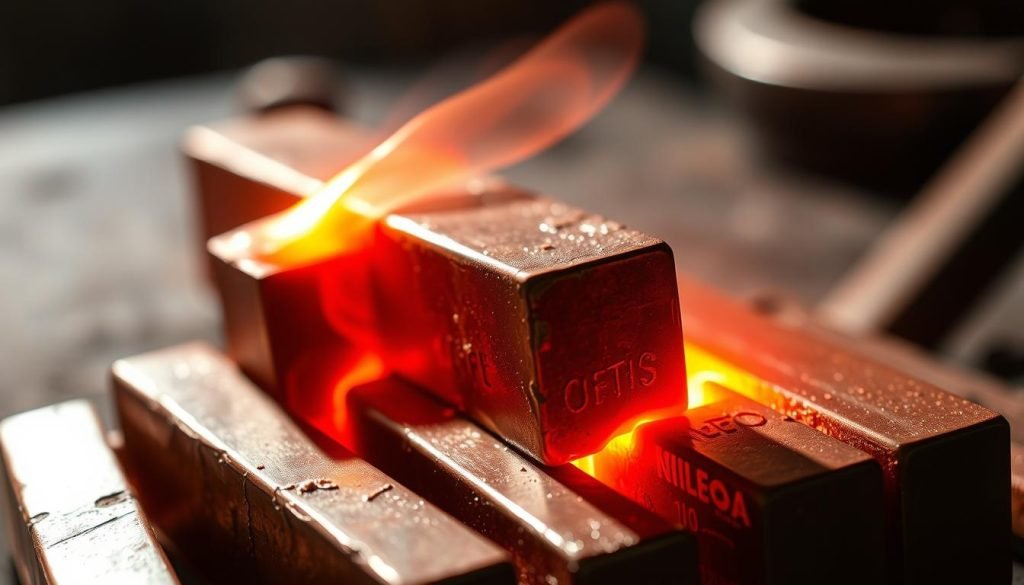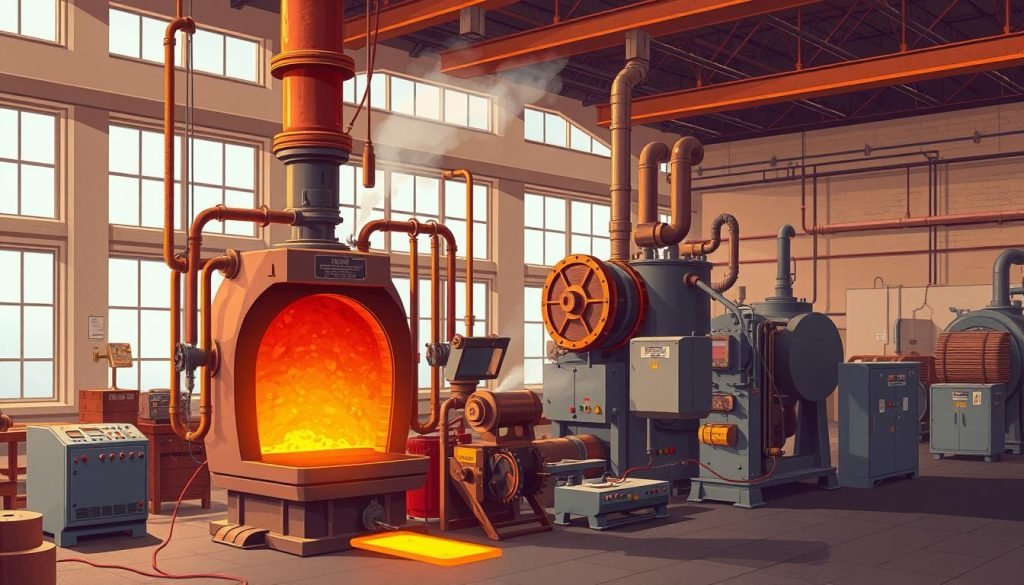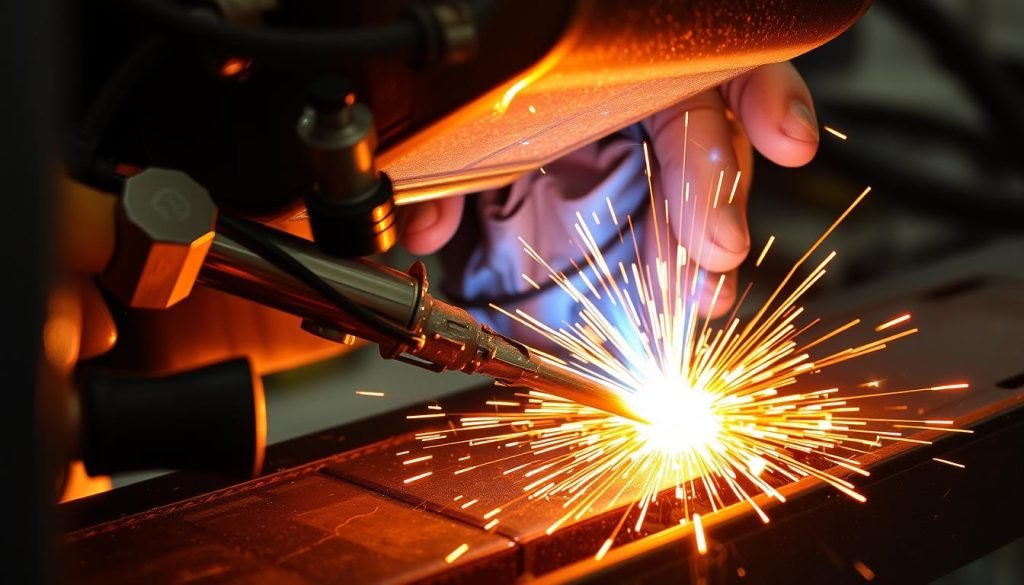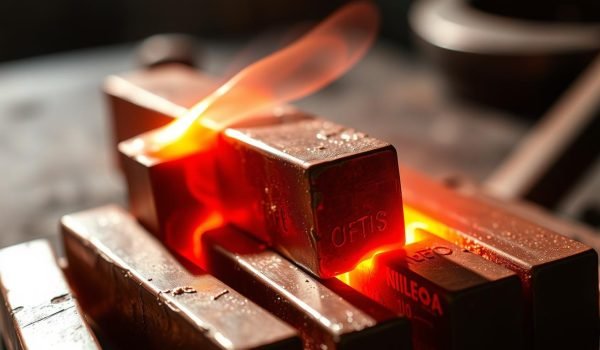Copper’s exceptionally high melting temperature of 1084°C (1983°F) makes it an ideal material for demanding applications, from electrical wiring to industrial manufacturing.
You might be surprised to learn that copper’s ability to withstand high temperatures is a key factor in its widespread use across various industries.
As we explore the fundamental properties of copper and its melting characteristics, you’ll gain insights into how this metal is utilized in different fields and what makes it so reliable for high-temperature applications.

Understanding the Melting Point of Copper
The melting point of copper is a fundamental property that influences its durability and heat resistance. To appreciate its significance, you first need to understand what a melting point is and how it applies to pure copper.
What is a Melting Point?
A melting point is the temperature at which a substance changes state from solid to liquid. This specific temperature is a characteristic property of each material, including metals like copper. Understanding the melting point is crucial for various industrial and manufacturing processes.
The Melting Point of Pure Copper
Pure copper has a melting point of 1,085°C (1,984°F), which is relatively high compared to many common metals. This high melting temperature contributes to copper’s excellent thermal stability, making it suitable for applications requiring heat resistance. When copper reaches its melting point, it transforms into a flowing liquid that can be cast or molded into various forms.
You’ll find that the melting point of pure copper serves as a baseline for understanding how alloying elements affect the melting behavior of copper-based materials. Understanding this property is crucial for precise manufacturing processes and quality control in industrial applications.
Copper Alloys and Their Melting Points
You will find that copper alloys have diverse melting temperatures based on their makeup. Copper alloys are engineered to have specific properties for various applications, and their melting points play a crucial role in their processing and use.
Common Copper Alloys
Copper alloys are widely used in different industries due to their excellent properties. Some of the most common copper alloys include brass, bronze, cupronickel, and aluminum bronze. Brass, an alloy of copper and zinc, is known for its ductility and acoustic properties, making it ideal for musical instruments. Bronze, primarily a copper-tin alloy, is valued for its strength and corrosion resistance. Cupronickel, which contains nickel, is highly resistant to corrosion and is often used in marine applications. Aluminum bronze, with its addition of aluminum, offers high strength and resistance to corrosion and wear.
These alloys are selected based on their specific characteristics, which are influenced by their composition.
Melting Temperature Ranges of Different Copper Alloys
The melting temperature of copper alloys varies significantly depending on their composition. For instance, brass typically melts between 900-940°C, which is lower than pure copper due to the influence of zinc. Bronze alloys generally melt in the range of 850-1050°C, with the exact temperature depending on the tin content and other alloying elements. Cupronickel alloys have higher melting points, typically between 1200-1300°C, making them suitable for high-temperature applications. Aluminum bronze alloys melt in the range of 950-1050°C, offering a good balance of castability and high-temperature performance.
Understanding these melting temperature ranges is crucial for proper processing, including casting, forging, and heat treatment of copper alloys. By knowing the melting points, you can better manage the manufacturing process and ensure the quality of the final product.
Factors Affecting the Melting Point of Copper
Copper’s melting behavior is influenced by multiple factors, including impurities, atmospheric pressure, and its internal microstructure. Understanding these factors is crucial for precise control over the melting process, especially in high-temperature applications.
Impurities and Their Impact
Impurities within copper can significantly alter its melting point. The presence of other elements can either lower or raise the melting temperature, depending on their type and concentration. For instance, certain impurities may form alloys with copper that have different melting characteristics than pure copper.
Atmospheric Pressure Effects
Atmospheric pressure also plays a role in determining the melting point of copper. Changes in pressure can influence the melting behavior, although this effect is generally less pronounced compared to the impact of impurities or microstructure. Understanding the interplay between pressure and melting point is essential for applications conducted under varying environmental conditions.
Microstructure and Grain Size Influence
The microstructure and grain size of copper have a profound impact on its melting properties. Copper with smaller grain sizes tends to melt more easily due to the increased number of grain boundaries, which can act as weak points. Conversely, larger grains or highly organized structures require more energy to melt, potentially raising the effective melting point. Processing methods like cold working, annealing, or rapid cooling can alter copper’s microstructure, subsequently affecting its melting characteristics. Understanding these microstructural effects is particularly important in precision manufacturing and when working with copper , which has undergone various forms of processing or heat treatment.
Comparison of Copper’s Melting Point with Other Metals
Understanding how copper’s melting point compares to other metals is crucial for various industrial applications. Copper’s melting point of 1084°C (1983°F) is a key characteristic that influences its use in manufacturing, electronics, and other fields.
Copper vs. Common Industrial Metals
When comparing copper to common industrial metals, its melting point is significantly higher than some, such as aluminum (660°C/1220°F) and zinc (419.5°C/787.1°F). This higher melting point makes copper more suitable for high-temperature applications.
Copper vs. Precious Metals
Copper’s melting point is slightly higher than gold (1064°C/1947°F) and significantly higher than silver (961°C/1764°F). This comparison is particularly relevant in applications like jewelry making and electronics, where these metals are often used together or as alternatives.
The Importance of Knowing the Melting Point of Copper
Knowing the exact melting point of copper is essential for optimizing manufacturing processes. This knowledge is critical in various industrial applications where copper is used, particularly in high-temperature environments.
Material Selection for High-Temperature Applications
When selecting materials for applications that involve high temperatures, understanding the melting point of copper is vital. You need to ensure that the material can withstand the operating temperatures without losing its integrity. Copper’s melting point helps you determine its suitability for such applications.
In high-temperature environments, the properties of copper, such as its conductivity and strength, are crucial. Knowing the melting temperature of copper allows you to assess whether it will perform as required under those conditions.
Process Control in Manufacturing
In manufacturing, precise control over the process is essential for producing high-quality copper components. The melting point of copper is a key factor in this process control. You need to ensure that copper is heated to the correct temperature during casting, welding, or other thermal processes.
Accurate temperature control prevents overheating, which can lead to oxidation and degradation of copper’s properties. By understanding the melting point, you can optimize energy usage and ensure that only the necessary amount of heat is applied, thereby maintaining the desired properties of the final product.
Process engineers rely on the melting point data to design appropriate heating cycles, cooling rates, and holding times. This information is crucial for achieving the desired microstructure and properties in copper components. Quality control procedures also reference the melting point as a benchmark for verifying that proper temperatures were maintained during manufacturing.
Ways of Melting Copper

To melt copper, one must choose the appropriate technique based on the scale and purpose of the operation. Melting copper is a process that requires achieving a temperature of around 1,984°F (1,085°C), and various methods can be employed to melt copper efficiently.
Industrial Melting Methods
Industrial settings often utilize large-scale furnaces, such as electric arc furnaces or induction furnaces, to heat melt copper. These furnaces are capable of reaching the high temperatures required for melting copper and can handle large volumes, making them ideal for manufacturing and production environments where melting is a critical step.
Laboratory and Small-Scale Melting Techniques
In contrast, laboratory and small-scale operations employ different melting techniques that focus on precision and flexibility. Methods include using crucible furnaces, oxy-fuel torches, or electric resistance heating. Crucible furnaces are particularly useful in small foundries and art studios, offering a simple and versatile way to melt small batches of copper at controlled temperature. Oxy-fuel torches provide a direct and concentrated heat melt source, popular for jewelry making and small repairs. Electric resistance furnaces are used in laboratory settings for their ability to provide clean, controlled heat, which is essential for precise melting operations that require careful energy management.
These small-scale methods, while requiring less infrastructure, demand greater operator skill to achieve consistent results. Understanding the various techniques for melting copper is crucial for selecting the most appropriate method for your specific needs, whether in industrial or small-scale settings.
Safety Considerations When Melting Copper
To ensure a safe working environment, understanding the safety considerations when melting copper is essential. Melting copper involves handling molten copper at high temperatures, which can be hazardous if not managed properly.
Protective Equipment and Ventilation
You must use proper protective equipment when melting copper to protect yourself from heat and potential splashes of molten metal. This includes heat-resistant gloves, safety glasses, and a face shield. Adequate ventilation is also crucial to prevent inhalation of fumes. Ensure your workspace is well-ventilated to maintain a safe environment.
Handling Molten Copper Safely
Safe handling of molten copper requires specialized tools and techniques. You should use crucibles, ladles, and tongs designed for high-temperature applications to prevent accidents. Maintaining a safe distance and following proper pouring techniques are also vital to prevent splashing and spills. Regularly monitoring the temperature of molten copper is necessary to ensure it remains within a safe range for handling.
Applications of Molten Copper in Manufacturing
Copper, when melted, becomes a versatile material used in numerous industrial applications. You can find molten copper being utilized in various manufacturing processes, including casting, molding, welding, and joining.
Casting and Molding Processes
Molten copper is used in casting and molding processes to create complex shapes and designs. You can achieve high precision and accuracy in the production of copper components, such as electrical contacts, heat sinks, and other specialized parts.
The casting process involves pouring molten copper into molds, allowing it to solidify, and then extracting the finished product. You must carefully control the temperature and cooling rates to ensure the quality of the final product.
Welding and Joining Applications
Molten copper plays a crucial role in various welding and joining processes. You can use it to connect copper components or join copper to other metals, particularly in electrical connections and plumbing.
- Brazing uses molten copper alloys as filler metals to join components without melting the base materials, creating strong joints with good electrical conductivity.
- Soldering with copper-based alloys provides lower-temperature joining options for electrical connections and plumbing.
- Copper welding processes must account for the metal’s high thermal conductivity, which can make it challenging to achieve localized melting without preheating.
Copper Welding Techniques Based on Melting Properties

Copper’s high melting point demands specialized welding techniques. When working with copper, it’s essential to understand its melting properties to choose the right welding method.
MIG and TIG Welding of Copper
MIG (GMAW) and TIG (GTAW) welding are commonly used for copper. These processes offer high precision and can handle copper’s high melting temperature. TIG welding, in particular, is favored for its ability to produce high-quality welds with minimal contamination.
Brazing and Soldering Copper
Brazing and soldering are alternative techniques that utilize filler metals with lower melting points than copper. Brazing involves heating the filler metal to a temperature between 450-850°C (840-1560°F), allowing it to flow into the joint. Soldering uses even lower temperatures and is ideal for applications where full mechanical strength isn’t required.
Both brazing and soldering require proper flux application to ensure strong metallurgical bonds and minimize thermal distortion.
Practical Tips for Working with Copper at High Temperatures
Copper processing at elevated temperatures requires careful consideration of various factors to achieve optimal results. To maintain the desired material characteristics, you must pay attention to temperature control, cooling rates, and copper’s thermal properties.
Preventing Oxidation and Contamination
When processing copper at high temperatures, preventing oxidation and contamination is crucial. You can achieve this by using inert atmospheres or protective coatings to shield the copper from reactive environments. Proper handling and storage techniques also play a significant role in minimizing exposure to contaminants.
Achieving Optimal Results in Copper Processing
To achieve optimal results, you should consider the appropriate cooling rate for your specific application, as it affects the microstructure and properties of copper. Understanding copper’s high thermal conductivity is also essential for designing effective heating and cooling strategies. Additionally, proper tool and die design should account for copper’s thermal expansion characteristics to achieve accurate final dimensions.
Conclusion
As we conclude our exploration of copper’s melting point, it’s clear that this property plays a crucial role in various industrial applications. You’ve gained insights into how copper’s melting point compares to other metals, its high-temperature capabilities, and the importance of understanding its melting behavior.
The melting points of various copper alloys offer options for tailoring material properties to specific application requirements. Factors affecting copper’s melting behavior, including impurities and microstructure, highlight the importance of quality control in manufacturing.
By applying the knowledge provided in this guide, you can make informed decisions about copper and its alloys for your specific applications, ensuring optimal performance and reliability in your products.




